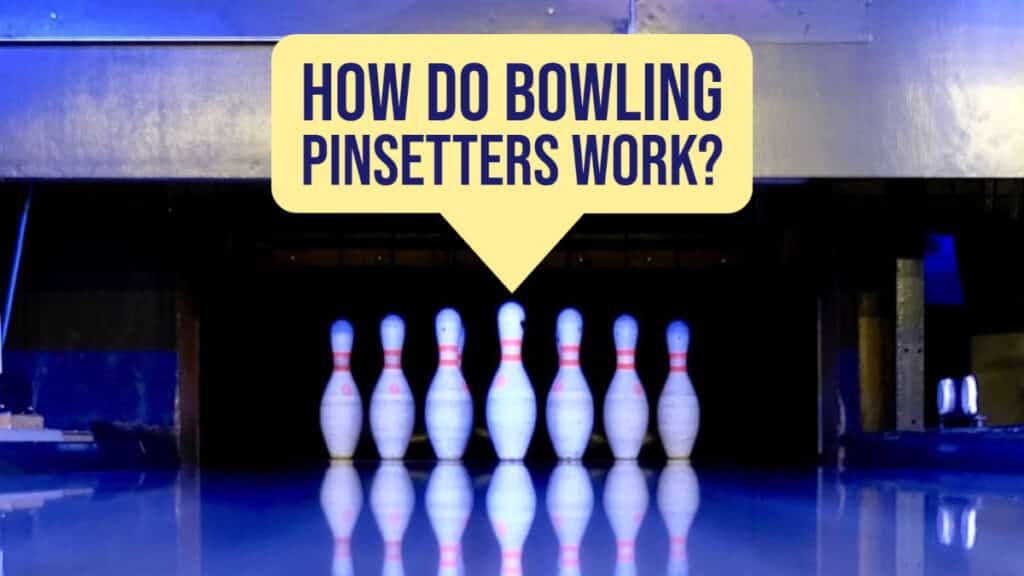Whether you are a bowling professional or a beginner, learning about the mechanics of bowling and the components of a bowling alley can always be fun and interesting. One incredibly important and technical part of bowling alleys is the bowling pinsetter. Learning about it will help improve your game to a great extent.
You might be wondering, how does a bowling Pinsetter work? Well, that is precisely what I am here to tell you.
In this article, I am going to talk about what bowling pinsetters are, how they work, and the different components of a bowling pinsetter. So, if you want to learn all there is to modern bowling pinsetters, make sure you read this article till the very end.

What Are Bowling Pinsetters?
Bowling pinsetters are automated mechanical devices that are used in modern bowling alleys to clear deadlifts, set pins, and return bowling balls to the bowling ball rack. These machines are operated by technicians to ensure maximum efficiency and working speed since bowling has become such a fast and quick sport over the years.
The first-ever pinsetter was patented to AMF in 1941 by Gottfried Schmidt. Before that time, pinsetters were not automated machines, and instead, individuals dubbed pin chasers who not only rearranged the pins and maintained them.
Even now manual pinsetters are employed in some bowling alleys but for the cleaning and maintenance of automated pinsetters alongside the technicians. Over the years, bowling pinsetters have become an integral part of the bowling sport making things so much easier and quicker which is why they are considered an amazing invention in the field of bowling.
How do Bowling Pinsetters Work?
All you can see is a pinsetter setting the pins and returning the bowling ball, but there is a lot more going on in the back end of the pin deck. Here are all the major components that come into play when the pinsetter takes action.
Pin Elevator
The first component of the bowling pinsetter is the pin elevator. It works in such a way that a rolling belt takes all the knocked pins also known as the deadlift and forces them onto shovels which each pick up a single pin in the horizontal position.
These shovels are located on the pin elevator and as the name suggests, the pin elevator elevates the pins and takes them to the top of the pin setting mechanism. Every single pin is taken up in a horizontal manner which is crucial to the right placement and setting of the pin itself.
Ball Pit
The Ball Pit is also an important part of the pinsetter. We know that a pin is designed to not only set the bowling pins but also return the ball to the bowling ball rack, well, the ball pit is where this process starts.
The ball pit, first, stops the impact of the bowling ball which is coming at full speed after knocking the balls, and then it places the ball on the rolling belt which slowly moves the ball towards the ball track where the next component comes into play.
Ball Accelerator
The Ball Accelerator is a component vital to the transportation of the bowling ball to the rack. Once the ball reaches the ball accelerator, it is pushed forward with a force onto the ball track which leads from in between two lanes and takes the ball from behind the lane to the front to the ball rack using the ball track path. That is why you never see the bowling ball rack empty.
Distributor
The distributor is what the pins meet when they are passed on from the pin elevator. They are first brought into a vertical position in a holder with the bottom down and then slid using a shark fin, which distributes the pins in two lines depending upon which has more pin space.
The pins are then held in a rack until the pin space is clear and then the pin will horizontally fall into the empty space so it can be used to replace the knocked pins once the turn is over.
Setting Table
The most important part of a pinsetter in the setting table. It is responsible for not only setting the pins but also checking if there are any pins that need to be replaced. There are pin detectors on the tip of the set tables that pick up pins if they detect any standing ones.
Whereas if there are no pins, the setting table rotates the pins into a vertical position and places them down perfectly symmetrical just the way they should be arranged onto the pin deck.
Sweeper
The Sweeper is a particularly important part of the pin-setting process as well. It comes down once a turn is completed so that no pin makes its way over the pin deck and becomes an obstruction.
Secondly, the sweeper sweeps any of the knocked pins and deadweight off the lane before the setting table sets the pins onto the pin deck. This is crucial to make sure no pinfalls because of the dead weight on the lane floor.
Motors
There are three motors that work in the pin-setting machine to power all the components effectively. The front motor operates the elevator, the distributor, and the rolling belt. The middle motor powers the sweeper whereas the back motor helps the setting table work properly. With the help of all these motors, the pinsetter machine works flawlessly otherwise it could not be powered to work.
Conclusion
Bowling pinsetters are incredibly vital to the working efficiency of a bowling alley as well as a professional bowling tournament. The time crunch of bowling competitions would not just work without a quick and highly accurate bowling pinsetter. That is why learning about these pinsetters will be great for your bowling knowledge. I hope that you learned a lot from this guide. Make sure you enjoy wholeheartedly, the next time you are in the bowling alley!




